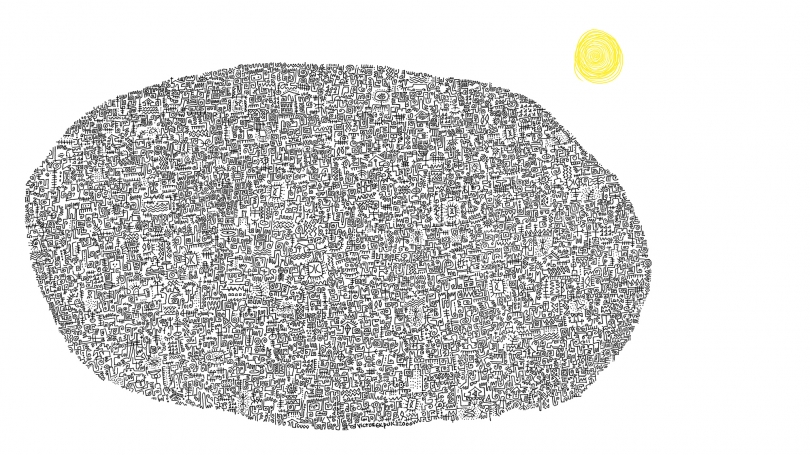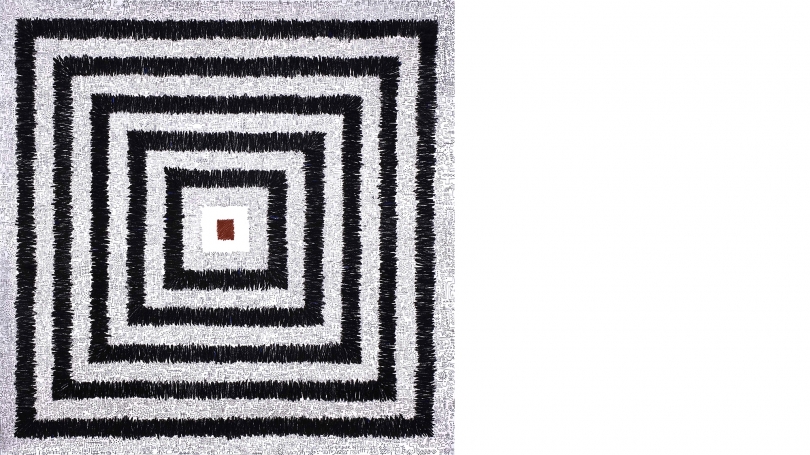This exhibition presents recent work by Washington, D.C.–based Victor Ekpuk. Born in 1964, Ekpuk trained at Obafemi Awolowo University, Ile Ife, in southwestern Nigeria, where he was first exposed to the possibilities of drawing. He developed his minimalist approach of reducing form to constituent lines while working as a cartoonist for Daily Times, a leading Nigerian newspaper, in the 1990s. A ceaseless experimentalist with the gestural qualities and sparse formalism of lines, Ekpuk considers drawing a fundamental aspect of his art practice, which also includes painting, printmaking, collage, sculpture, installation, and public art projects.
Ekpuk composes script-like forms in a staccato fashion with symbols ricocheting off each other, yet carefully amassed on the picture surface. His visual language evolved from the ideographic and gestural nsibidi, an autochthonous communication system of the Ekpe secret society, a trans-ethnic men's association active in the southern border regions of Nigeria and Cameroon. Early in his career, he was mostly interested in nsibidi as an aesthetic resource, pushing the formal possibilities of the ideographic forms and gaining his own unique artistic voice. He has since become adroit at inventing his own scripts of dots, scratches, scrawls, contrived signs, and schematized figures. Yet nsibidi remains a point of departure, a cultural memory. As Ekpuk has often stated, memory—understood as a stream of consciousness that encapsulates human experiences, lived and imagined, inherited or received, personal and collective—is at the core of his practice. Nsibidi (as well as the artist's invented signs) represent this idea in his work, and are inscribed and reiterated on canvas, acid-free paper, board, and recently, wall.
During a three-month residency at the Thami Mnyele Foundation in Amsterdam in 2007, Ekpuk recognized the principal place graphic signs occupy in his practice. He decided to approach drawing as a form of creative expression with its own merits, rather than as an initial context of expression in which perfunctory ideas are tried out before being transferred to more permanent surfaces. His Composition series, which he began during the Amsterdam residency and ended in 2013 during another residency in Santa Fe, New Mexico, was the result of this focused attempt.
Sanctuary (2008), one of the first works from the series, captures Ekpuk's intense mark-making approach and, at the same time, his indebtedness to nsibidi. The drawing is composed of six squares in a retreating format, one following the other, outlined with bold marks drawn with compressed charcoal. Ekpuk fills the white spaces between the black square outlines with his marks. The only remaining white space is the square surrounding the tiny red square in the middle of the picture surface. The texture of the composition creates a three-dimensional illusion. Ekpuk reduces forms to basics and expunges the superfluous, yet Sanctuary is not devoid of meaning. The repeating squares are a symbol of the Ekpe lodge through which Ekpuk reflects on the Ekpe principles of spiritual enlightenment and hierarchies of knowledge. With the work, arguably, he makes a symbolic return to Ekpe society as a sanctuary of cultural memory.
The intense repetition of the artist's own invented forms juxtaposed with nsibidi signs is characteristic of all eighteen works in Auto-Graphics. The exhibition includes Ekpuk's whimsical collages, digital prints, and supersized drawings—bold, vibrant, yet restrained compositions in which nsibidi emerge as bristling opaque forms that contrast with the more figural works on view. Ekpuk's scripts do not always provide a formal roadmap or a logical point of access for the beholder. Yet there is clarity in the transparency of his compositions. Like nsibidi, which take shape both through visible marks and corresponding physical gestures, Ekpuk's immersive drawings seem to be choreographed with the full force of his body. At once expressive and disciplined, Ekpuk's draftsmanship reveals a close kinship between the autographic practices of drawing and writing.
In conjunction with his exhibition at the Hood, Ekpuk will draw a work directly on the gallery wall—an ample surface on which to explore the infinite potential and ephemeral fate of the hand-drawn line—in what the artist refers to as drawing performance. In the conscious act of creating with both serious and playful intents, effortless and controlled, sensual and thoughtful, he invites viewers to follow the pulsating rhythms of his drawing and to share in his experience(s) momentarily, without necessarily understanding the marks on the wall. The mural will be erased at the end of the exhibition in a final act that gestures to life's ceaseless cycle of birth, death, and possibly, renewal.
This exhibition, on view from April 18 to August 2, was organized by Krannert Art Museum, University of Illinois at Urbana-Champaign, and curated by Allyson Purpura. It was partially supported by a grant from the Illinois Arts Council Agency. The exhibition's presentation at the Hood Museum of Art, Dartmouth College, was generously supported by the Leon C. 1927, Charles L. 1955, and Andrew J. 1984 Greenebaum Fund and the Cissy Patterson Fund.
Related Exhibitions
- Auto-Graphics: Works by Victor Ekpuk
- Ukara: Ritual Cloth of the Ekpe Secret Society
- Inventory: New Works and Conversations around African Art
Related Stories


